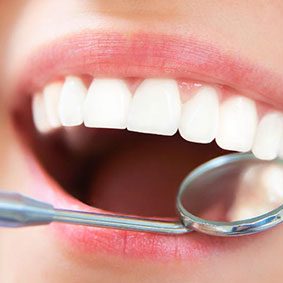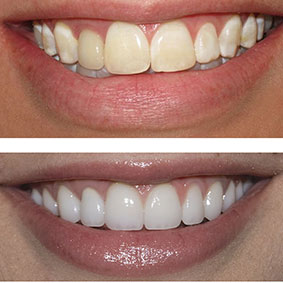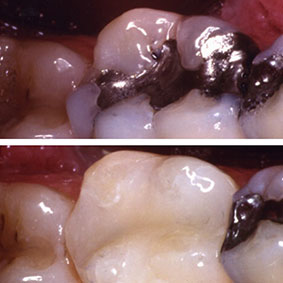Teeth Whitening
Do you want a beautiful smile? Whitening your teeth is one of the easiest things you can do to improve your smile and boost your self-confidence. Imagine, a single whitening procedure can counteract years of exposure to coffee, tea, red wine, cola and smoking, giving you the smile you’ve always dreamed of!


Cosmetic Bonding
If you have teeth that have stains that cannot be removed by bleaching, and veneers or crowns are not necessary, then cosmetic bonding might be a good option for you. Cosmetic bonding is an affordable, quick and painless way to repair many cosmetic flaws or injuries, including:
- Gaps in teeth
- Spots or stains
- Chipped teeth
Dental bonding sculpts individual teeth without requiring removal of any tooth structure. This technique bonds a composite material that looks, acts and feels like the real thing, to an existing tooth. This procedure usually doesn’t require the use of an anesthetic; is relatively quick to apply; gives an immediate result and is less expensive than veneers
White Composite Fillings
Until recently, dentists used a silver and mercury amalgam to fill and seal cavities. Because a larger amount of the original tooth must be removed, these types of fillings often weaken teeth. Recent innovations now allow us to replace old silver fillings with composite or porcelain fillings that are stronger, safer and more natural looking. Say goodbye to “metal mouth” and hello to a beautiful new smile.


Crowns
Teeth are often restored using silver or porcelain fillings. However, when too much of a tooth’s structure is removed to support a filling, a crown or “cap” may be needed. A crown may be needed to:
- Restore a tooth when it is unable to support a large filling
- Attach bridges
- Protect a weak tooth from fracturing or restore fractured teeth
- Cover badly shaped or discolored teeth
- Cover dental implants
A crown essentially covers a tooth to restore it to its natural shape and size. This permanent covering fits over your original tooth to strengthen or improve the appearance of the tooth. Fitting a crown generally requires at least two visits to the dentist’s office.
Inlays and Onlays
When more than a third of a tooth’s biting surface is damaged, a dentist will often use an inlay or onlay. Large fillings on back teeth often require a stronger and properly contoured restoration, such as porcelain inlays or onlays. They are created at an off-site dental lab and are bonded into place using a strong resin. Inlays and onlays protect teeth similarly as crowns, but conserve more natural tooth structure and are a better match to your tooth’s natural color.


Bridges
Healthy and strong teeth support and maintain your jaw alignment. That is why when you lose one or more teeth, your remaining teeth may shift, and the ability to chew and speak may be affected. A bridge replaces missing teeth with artificial teeth, eliminating the gap where those teeth had been. The bridge is bonded onto surrounding teeth for support. Regardless of the type of bridge recommended, its success depends on keeping the surrounding teeth healthy and strong.
Dentures
Missing teeth can create a host of aesthetic and functional problems including sagging facial muscles, inability to eat certain foods and speak. Dentures may be your best solution if you’ve lost all your natural teeth due to periodontal disease, tooth decay or injury.
Fitting a patient for dentures does not have to be a traumatic experience. During the preliminary visit, the remaining teeth are removed and a model is made of the patient’s jaw. An immediate denture may be fitted so the patient does not have to be without teeth while the mouth tissue heals. Once the mouth tissue is completely healed, the patient is fitted with their custom dentures .


Implants
When you lose a tooth, a dental implant may be needed to replace the tooth root and crown. Dental implants are simply “anchors” that permanently support replacement teeth. They are secure and durable and can be cleaned and cared for much like your natural teeth. The procedure requires a titanium root be fitted into your jaw to replace the lost tooth’s root. Once the implant is anchored into the bone, the bone around the implant requires six weeks to six months of healing. Once the bone has healed, a support post and replacement tooth is anchored onto the implant
